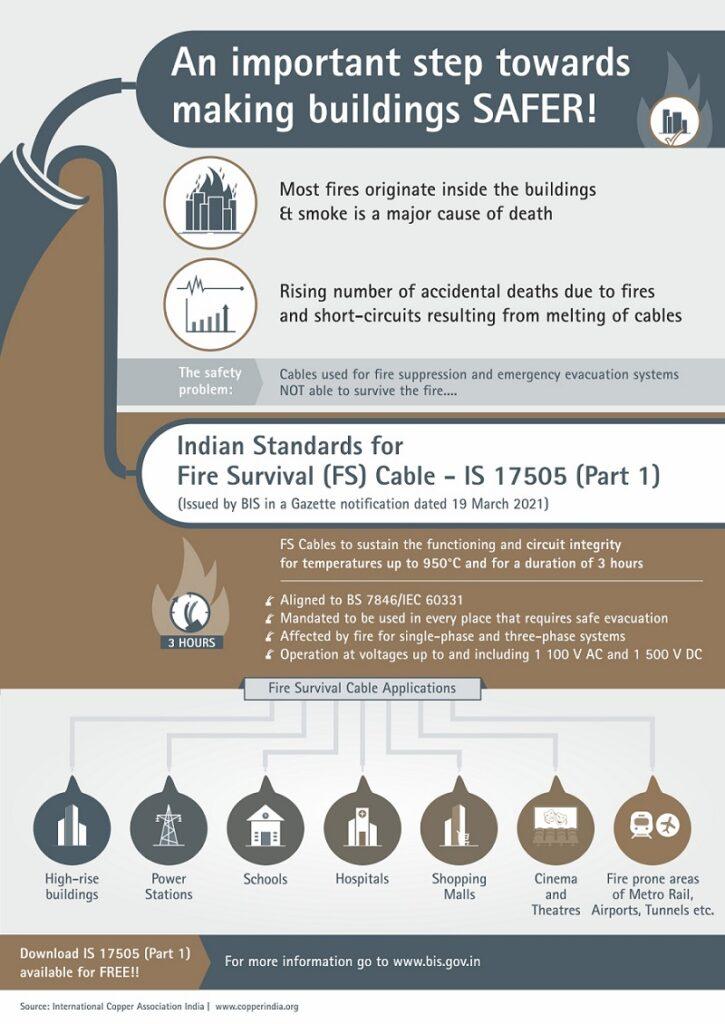Indian Standards for Fire Survival Cable – 4 Things You Must Know
The Indian Standard for Fire Survival Cable which has been under consideration by the Bureau of Indian Standard (BIS) is now published by BIS in a Gazette notification dated 19 March 2021.
In observation of a rising number of accidental deaths and property loss due to fires in Buildings, historically as well as in recent times mostly caused due to Electrical networks, the Fire Survival Cable hold immense importance in raising the benchmark for Building safety.
INDIAN STANDARD FOR FIRE SURVIVAL CABLE: IS 17505 (PART 1)
Title: Specification for Thermosetting Insulated Fire Survival Cables for Fixed Installation having Low Emission of Smoke and Corrosive Gases when Affected by Fire for Working Voltages upto and including 1100 Vac and 1500 Vdc
Here are 4 points that must be noted with respect to the adoption and implementation of Indian Fire Survival Cable Standards:
1. INDIAN STANDARD IS 17505 SETS A NEW BENCHMARK DRAWING FROM BS 7846
Until now, the domestic industry has been benchmarking itself to the British Standard BS 7846 for fire-survival cables. The Cables are supposed to withstand temperatures up to 950°C for at least three hours. This is to ensure that elevators, fire pumps and all other emergency circuits are operational to ensure a safe passage for inhabitants. With the publication of IS 17505 (Part I), the new standards can now be used as a benchmark by manufacturers and users.
This Indian Standard IS 17505 (Part 1) has been developed keeping in mind the specific needs of the Indian industry and are aligned with other international specifications like BS 7846/IEC 60331.
2. MAINTAINING CIRCUIT INTEGRITY –
The IS 17505 specifies the stringent quality requirement of cable to maintain circuit integrity in fire condition. While the Standard covers the various categories of FS Cable applications the ability to sustain hazards such as high temperature, fire, water, and mechanical impact, and still be able to maintain the electrical supply for equipment essential for fire warning, evacuation or suppression is at its core. As per the standards FS Cables must be able to sustain the functioning and circuit integrity for temperatures up to 950°C and for duration of 3 hours. Standard advocate use of only Copper conductor, with its higher melting point, offers a distinct advantage when it comes to use in Fire Survival Cables.
The requirements specified in the standards with respect to maintaining the circuit integrity in conditions of fire will aid in significantly enhancing the safety of buildings and reducing the risks to life and assets in case of an fire.

3. IMPLEMENTATION FOR FIXED INSTALLATIONS AS PER GUIDELINES OF NATIONAL BUILDING CODE
The IS 17505 must now be used in every place where safe evacuation of personnel in case of a fire is essential as per guidelines of National Building Code, while maintaining the essential electrical services for a defined period of time. The Cables with Indian Standards for Fire Survival may be used in high-rise buildings, power stations, schools & all kinds of Educational Institutions, hospitals, shopping malls, cinema halls etc. The cables are also mandated to be used in fire prone areas of a variety of infrastructure projects such as Metro Rail, Airports, and Tunnels etc.
Together, in their indoor and outdoor applications, the Fire Survival cables following the Indian Standards will play a critical role in enabling better fire safety.
4. CABLE INSULATION SPECIFICATION FOR BETTER PROTECTION AGAINST FIRE
Insulation plays a critical role in maintaining the functioning of Cables in hazardous conditions for a defined period of time. This Indian Standard covers the requirements of thermosetting insulated armored fire survival cables for fixed installations having low emission of smoke and corrosive gasses for maintaining circuit integrity when affected by fire for single-phase and three-phase systems, suitable for operation at voltages up to and including 1 100 V AC. and 1 500 V DC.
The standards also specify the related requirements for Conductor, Screening, and Insulation for Inner Sheath, Armoring, Screening and Outer Sheath for the Cables.
CONCLUSION
Fire mishaps are a serious concern. The loss of human life and damage to the assets in the building indicate higher risks of operations in the Building and affect the reputation of business and services. Several research studies highlight the fact that most fires originate inside the buildings and smoke identified as the most common cause of death. Greater use of composite materials, plastics in the Building infrastructure has reduced the time from ignition to a fire flash.
In the instance of a fire, if the cabling systems are damaged even the most sophisticated alarm and emergency fire evacuation systems will be rendered of no use. Greater adoption and use of Fire Survival Cables as recommended by the IS 17505 (Part 1) are therefore critical to raising the safety standards for every building; reducing the risks from fire and ensuring complete confidence in the building facility.


